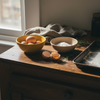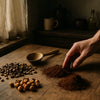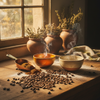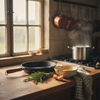How to Zest Lemons and Limes: Pro Techniques & Tools
Key Takeaways
- Mastering how to zest lemons and limes can elevate the flavor of your dishes significantly.
- The fragrant oils in citrus peels are key to adding bright, fresh notes to recipes.
- Proper zesting techniques help release these oils without including the bitter pith.
- Knowing the right tools and methods ensures a clean and effective zest.
Table of Contents
- What Is Citrus Zest? The Science Behind the Flavor
- Essential Tools for Zesting: What Works Best
- Step-by-Step: How to Zest a Lemon Without a Zester
- Avoiding Bitter Pith: Precision Zesting
- What Is Citrus Zest? The Science, Flavor & Culinary Magic
- Essential Tools for Zesting Lemons and Limes: Pros, Cons & Best Picks
- Step-by-Step: How to Zest a Lemon or Lime with Each Method
- The Art of Avoiding Bitter Pith: Precision Zesting Without Compromise
- Zester vs. Grater vs. Peeler: Which Method Is Best for You?
- Real-World Zesting Scenarios & Solutions for Home Chefs
- How to Store Citrus Zest: Freshness, Flavor & Safety
How to Zest Lemons and Limes: Pro Techniques & Tools
Mastering how to zest lemons and limes transforms ordinary dishes into restaurant-quality creations. The difference between bland and brilliant often comes down to those fragrant oils locked in citrus peels, and knowing exactly how to release them without the bitter bite of pith.
Whether you're elevating a weeknight pasta or perfecting holiday desserts, the right zesting technique paired with quality tools makes all the difference. Let's break down the science, methods, and equipment that turn citrus zesting from guesswork into precision.
For anyone looking to upgrade their kitchen, investing in kitchen utensils designed for precision zesting can streamline your prep and ensure consistent results every time.
What Is Citrus Zest? The Science Behind the Flavor
Citrus zest is the thin, colored outer layer of lemon and lime peels, packed with volatile essential oils that deliver intense flavor without acidity. Unlike juice, which adds tartness, or pith (the bitter white layer beneath), zest provides pure aromatic intensity.
The science is simple: oil glands in the zest contain limonene and other compounds that create that signature citrus punch. Lemon zest offers bright, floral notes, while lime zest brings sharper, more tropical intensity. One tablespoon of zest delivers more concentrated flavor than two tablespoons of juice, without added liquid that can throw off recipe ratios.
Quick Distinction: Zest = flavor oils, Juice = acidity, Pith = bitterness. Master this trio and you control citrus like a pro.
Essential Tools for Zesting: What Works Best

Your tool choice determines whether you get restaurant-quality zest or bitter, chunky disappointment. Each method produces different textures and requires specific techniques.
Microplane Grater - The Fine Zest Champion
Best for: Baking, cocktails, and recipes requiring evenly distributed citrus flavor
Microplanes create the finest, most consistent zest texture. Their razor-sharp teeth slice cleanly through the peel without tearing, producing fluffy, snow-like zest that incorporates seamlessly into batters and doughs.
Classic Zester - Decorative Strip Master
Best for: Garnishes, cocktail twists, and visual presentation
The traditional zester with its row of small holes creates thin, uniform strips perfect for garnishing desserts or rimming cocktail glasses. Requires steady pressure and smooth strokes for consistent results.
Box Grater - The Bulk Solution
Best for: Large batches and when you need significant zest volume
Use only the finest side of your box grater. While less precise than specialized tools, it handles multiple fruits efficiently when making large batches of marinades or preserves.
| Tool | Texture | Speed | Precision | Best Use |
|---|---|---|---|---|
| Microplane | Ultra-fine | Fast | Excellent | Baking, cocktails |
| Classic Zester | Thin strips | Medium | Good | Garnishes |
| Box Grater | Variable | Very fast | Fair | Large batches |
Step-by-Step: How to Zest a Lemon Without a Zester
No specialized zester? No problem. Learning how to zest a lime with a knife or improvising with common kitchen tools delivers professional results with proper technique.
Paring Knife Method
Use a sharp paring knife to remove thin strips of peel, avoiding the white pith. Hold the fruit firmly and work in smooth, consistent strokes. Once you have strips, stack them and slice into thin julienne, then mince finely for recipe use.
Vegetable Peeler Technique
A sharp vegetable peeler removes broader strips than a knife. Peel in long strokes, then stack the strips and cut into desired sizes. This method works exceptionally well when you need larger pieces for infusions or garnishes, while a Kitchen Tool For Zesting Citrus is best for creating fine, aromatic shreds.
For any method, wash citrus thoroughly first and work over a clean cutting board to catch every precious bit of zest. One medium lemon yields approximately one tablespoon of zest, while limes produce about two teaspoons each.
Avoiding Bitter Pith: Precision Zesting
The white pith beneath citrus zest contains compounds that turn your carefully crafted dish bitter and astringent. Visual cues help you stop at exactly the right depth, zest should be purely colored with no white showing.
Apply gentle, consistent pressure regardless of your tool. Heavy-handed zesting digs too deep, while too-light pressure wastes the fruit's potential. Rotate the fruit frequently, working only the colored surface for best results.
What Is Citrus Zest? The Science, Flavor & Culinary Magic

Citrus zest is the thin, colored outer layer of citrus peel that contains concentrated essential oils called limonene and citral. This aromatic powerhouse delivers pure citrus flavor without the acidity of juice or bitterness of the white pith beneath.
The science is simple: citrus fruits store their most potent flavor compounds in tiny oil glands within the zest. When you learn how to zest lemons and limes properly, you're extracting these oils at their peak concentration, up to 95% of the fruit's aromatic compounds live in this colorful outer layer.
Zest vs. Juice vs. Pith: What's the Difference?
- Zest: Pure flavor oils, bright aroma, no bitterness
- Juice: Acidic liquid, adds tartness and moisture
- Pith: White layer beneath zest, bitter and tough
Lemon zest offers floral, slightly sweet notes perfect for baking and desserts, while lime zest delivers sharper, more tropical flavors ideal for savory dishes and cocktails. Both transform ordinary recipes, from vinaigrettes to cheesecakes, with minimal effort and maximum impact.
Essential Tools for Zesting Lemons and Limes: Pros, Cons & Best Picks
Tool selection determines your zesting success. The right implement delivers consistent results while protecting your fingers and preserving flavor integrity. Professional chefs rely on specific tools for good reason, precision matters when extracting delicate oils without bitter pith contamination.
| Tool | Precision | Safety | Cleanup | Versatility |
|---|---|---|---|---|
| Microplane Grater | Excellent fine zest | Requires care | Easy rinse | Cheese, spices, garlic |
| Classic Zester | Perfect strips | Very safe | Simple wash | Decorative garnish only |
| Box Grater | Coarse results | Finger-friendly | Multiple surfaces | All grating needs |
| DI ORO Seamless Tools | Professional grade | Ergonomic design | No-crevice cleaning | Heat-resistant to 600°F |
DI ORO's seamless design eliminates bacteria-harboring crevices while delivering the precision trusted by America's Test Kitchen. Our forever-chemical-free construction means your zest stays pure, and our award-winning tools perform consistently whether you're zesting citrus or tackling any culinary challenge.
For more tips on using your utensils for various cooking techniques, check out how to saute onions for flavor-packed results in your kitchen.
Step-by-Step: How to Zest a Lemon or Lime with Each Method
Proper preparation maximizes yield and flavor. Select firm, unblemished fruit with vibrant color, these contain the most essential oils. Wash thoroughly under cool water and dry completely before zesting.
Microplane Technique
Hold the grater at a 45-degree angle. Apply gentle, consistent pressure while moving the fruit in short strokes across the blade. Rotate the fruit after each pass to avoid the bitter pith. Average yield: 1 tablespoon per lemon, 2 teaspoons per lime.
Classic Zester Method
Position the zester's small holes against the fruit's surface. Pull steadily to create thin strips, maintaining light pressure to stay in the colored layer. This method produces decorative curls perfect for garnishing cocktails or desserts.
Box Grater Approach
Use the finest holes on your grater's surface. Work in gentle circular motions, rotating the fruit frequently. This method works best for large batches but requires extra attention to avoid over-zesting into the pith.
Safety First!
Keep fingers curved away from blades. Stop when you see white pith appearing. Clean tools immediately after use to prevent oil buildup that can turn rancid.
For a deeper dive into the science and history of zesting, see this comprehensive overview of zester tools.
The Art of Avoiding Bitter Pith: Precision Zesting Without Compromise

Pith, the white layer beneath colored zest, contains compounds called limonin and naringin that create harsh bitterness. Visual identification is key: stop immediately when white appears beneath your tool.
Master zesting requires understanding pressure dynamics. Light, consistent strokes extract oils without penetrating the pith layer. Frequent fruit rotation ensures you're always working fresh surface area, preventing over-extraction in any single spot.
3 Mistakes That Lead to Bitter Zest (and How to Avoid Them)
- Heavy-handed pressure: Use feather-light strokes, letting the tool do the work
- Working the same spot repeatedly: Rotate fruit constantly for even extraction
- Ignoring visual cues: Stop the moment white pith becomes visible
Professional chefs test their pressure on a small area first, establishing the right touch before committing to full zesting. This technique prevents waste and ensures consistent flavor throughout your ingredient preparation.
Zester vs. Grater vs. Peeler: Which Method Is Best for You?
Each tool produces distinct zest textures for different culinary applications. Understanding these differences helps you choose the right method for your specific recipe needs and kitchen workflow.
| Method | Zest Texture | Time Required | Pith Risk | Best Use Case |
|---|---|---|---|---|
| Microplane | Fine, powdery | 30 seconds | Medium | Baking, cocktails |
| Classic Zester | Thin strips | 45 seconds | Low | Garnish, decoration |
| Box Grater | Coarse pieces | 60 seconds | High | Large batches, marinades |
| Y-Peeler | Wide ribbons | 90 seconds | Very low | Candied peels, twists |
DI ORO's seamless design eliminates the cleaning challenges that plague traditional tools with crevices and joints. Our professional-grade construction maintains sharp edges longer while preventing bacterial buildup that can affect flavor integrity in stored zest.
If you're interested in more kitchen techniques, you might also enjoy learning how to cook with stainless steel for optimal results.
Real-World Zesting Scenarios & Solutions for Home Chefs
Picture this: Mom's arriving in three hours, and your lemon bars need fresh zest for that signature brightness. Soft, overripe lemons challenge even experienced cooks, but the right technique saves the day.
For soft citrus, refrigerate fruit for 15 minutes before zesting, firmer skin prevents tearing and delivers cleaner results. When your tool gums up mid-recipe, a quick rinse in warm water and gentle brush removes oil buildup instantly.
5 Real-World Problems & Fixes
- Clumped zest: Toss with a pinch of sugar to separate
- Tool clogging: Rinse in warm water, brush gently
- Overripe fruit: Chill 15 minutes before zesting
- Measuring confusion: 1 medium lemon = 1 tablespoon zest
- Storage emergency: Freeze fresh zest in ice cube trays with water
Professional kitchens rely on DI ORO tools because consistency matters when reputation is on the line. Our award-winning design delivers the same reliable results whether you're zesting for a family dinner or holiday entertaining.
For additional food prep inspiration, see how long to grill chicken thighs for juicy, flavorful results every time.
How to Store Citrus Zest: Freshness, Flavor & Safety

Fresh zest loses volatile oils rapidly, use within three minutes of extraction for maximum flavor impact. Essential oils begin evaporating immediately upon exposure to air, diminishing the bright, concentrated taste that makes zesting worthwhile.
| Storage Method | Shelf Life | Flavor Retention | Best Application |
|---|---|---|---|
| Fresh (immediate use) | 3 minutes peak | 100% | Finishing dishes, cocktails |
| Refrigerated airtight | 3-5 days | 70% | Baking, marinades |
| Frozen in portions | 3 months | 85% | Cooked dishes, sauces |
| Dried at room temp | 6 months | 40% | Spice blends, rubs |
Forever-chemical-free tools like DI ORO's prevent contamination during storage preparation, ensuring your carefully extracted zest maintains its pure flavor profile throughout its storage life.
For more on food safety and best practices, visit this quick guide to zesting citrus safely.
Frequently Asked Questions
What is the difference between citrus zest, juice, and pith, and how do they each affect the flavor of a dish?
Citrus zest is the thin, colored outer layer of the peel packed with aromatic oils that add bright, fresh flavor without acidity. Juice provides tartness and acidity, while pith, the white layer beneath the zest, adds bitterness. Mastering these elements lets you balance citrus flavor precisely in your dishes.
Which tools are best suited for zesting lemons and limes, and how do their results differ in texture and use?
Microplanes and fine graters are ideal for producing fine, aromatic zest perfect for baking and garnishes, while peelers or channel knives create larger strips suited for infusions or cocktails. Each tool offers a different texture, so choosing the right one depends on your recipe and desired zest presentation.
How can I zest lemons or limes effectively without including the bitter white pith?
Zest gently using a microplane or fine grater, applying light pressure and rotating the fruit to remove only the colored outer peel. Avoid digging too deep to prevent the bitter pith from mixing in, ensuring your zest stays bright and flavorful.
What are the best practices for storing citrus zest to maintain its freshness and flavor?
Store fresh zest in an airtight container in the refrigerator and use it within a day or two for peak flavor. For longer storage, freeze zest in small portions or dry it completely to preserve its aromatic oils without losing intensity.




